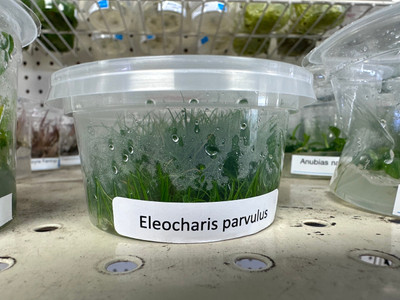Exploring Eleocharis Parvula: The Dwarf Hairgrass Aquatic Plant
Posted by Max Gandara on on 20th Jun 2023
Exploring Eleocharis Parvula: The Dwarf Hairgrass Aquatic Plant
Eleocharis parvula, commonly known as Dwarf Hairgrass, is a popular and
sought-after aquatic plant among aquarium enthusiasts and aquascapers.
Its graceful appearance, ease of cultivation, and ability to create a
lush carpet-like effect make it a favorite choice for both beginners and
experienced hobbyists. In this article, we will delve into the
fascinating world of Eleocharis parvula, exploring its characteristics,
care requirements, and its role in aquascaping.
Description and Characteristics:
Eleocharis parvula is a species of grass-like plant belonging to the
Cyperaceae family. It is native to North America, where it can be found
growing in marshes, wet meadows, and shallow water bodies. In the
aquarium setting, Dwarf Hairgrass is valued for its vibrant green color,
slender and elongated leaves, and its ability to form a dense,
carpet-like mat.
The plant typically grows to a height of 3 to 7 centimeters (1.2 to 2.8
inches), making it an excellent choice for foreground planting. Each
stem produces thin, hair-like leaves that can reach lengths of 4 to 10
centimeters (1.6 to 3.9 inches). Under optimal conditions, it forms a
lush, grassy carpet that adds a touch of natural beauty to any aquarium.
Care Requirements:
Dwarf Hairgrass is relatively undemanding, making it suitable for
beginners. However, providing the right conditions is crucial for its
success:
1. Lighting: Adequate lighting is essential for Eleocharis parvula's
growth. It thrives under moderate to high-intensity lighting (around 0.5
to 2 watts per liter) to ensure photosynthesis and healthy growth.
2. Substrate: A nutrient-rich substrate is necessary for this plant. A
mixture of fine-grained, nutrient-rich soil and sand is ideal for
promoting healthy root development. This plant requires a well-drained
substrate to prevent rotting.
3. CO2 and Nutrients: Carbon dioxide (CO2) supplementation and a
nutrient-rich environment are beneficial for optimal growth. CO2
injection or liquid carbon supplements can be used, along with a
comprehensive fertilization regimen that includes macronutrients
(nitrogen, phosphorus, potassium) and micronutrients.
4. Water Parameters: Dwarf Hairgrass prefers slightly acidic to neutral
water conditions, with a pH range of 6.0 to 7.5. The temperature should
be maintained between 22°C to 26°C (72°F to 79°F). Soft to moderately
hard water with a GH range of 4 to 10 is suitable for its growth.
Propagation and Maintenance:
Eleocharis parvula reproduces through runners, known as stolons, which
spread horizontally across the substrate. As the plant develops, these
stolons produce new plantlets, enabling the carpet to expand over time.
To encourage propagation, regular trimming of the carpet is recommended
to prevent excessive growth and shading.
It is important to maintain good water circulation in the aquarium to
prevent the accumulation of debris and algae. Regular water changes and
substrate vacuuming help to keep the environment clean and maintain
optimal conditions for the plant's growth.
Aquascaping Applications:
Dwarf Hairgrass is a versatile plant that offers numerous possibilities
for aquascaping. Its low-growing nature makes it ideal for creating a
lush carpeted foreground that adds depth and dimension to an aquarium
layout. When combined with other plants, rocks, and driftwood, it
creates a natural, visually appealing aquatic landscape.
Additionally, Dwarf Hairgrass can be utilized in Dutch-style aquascapes,
where it acts as an excellent accent plant, providing contrast in an
aquascape.

